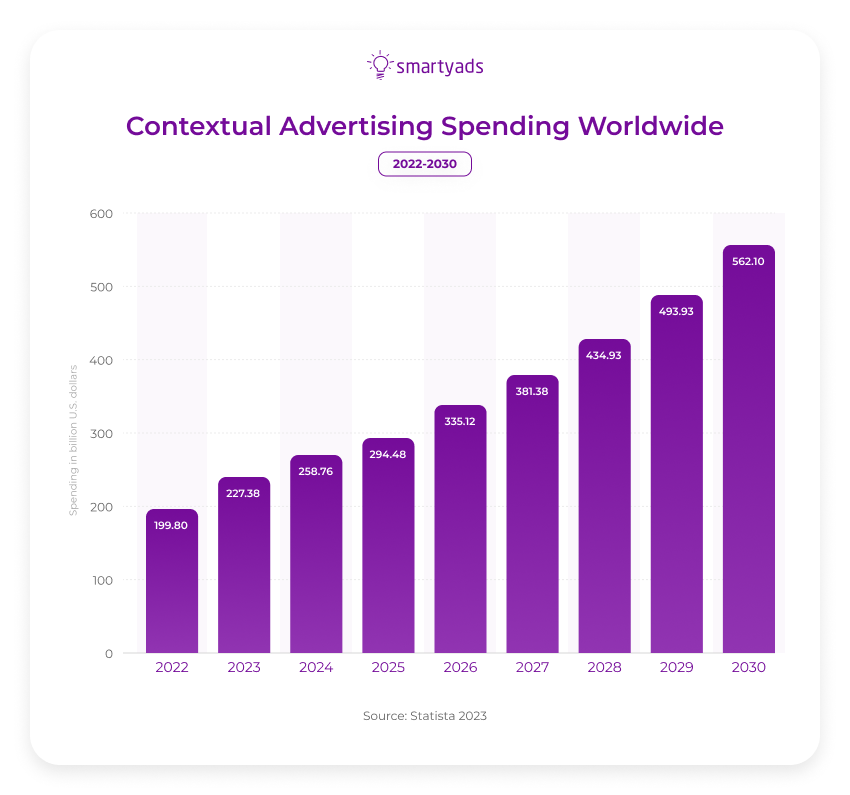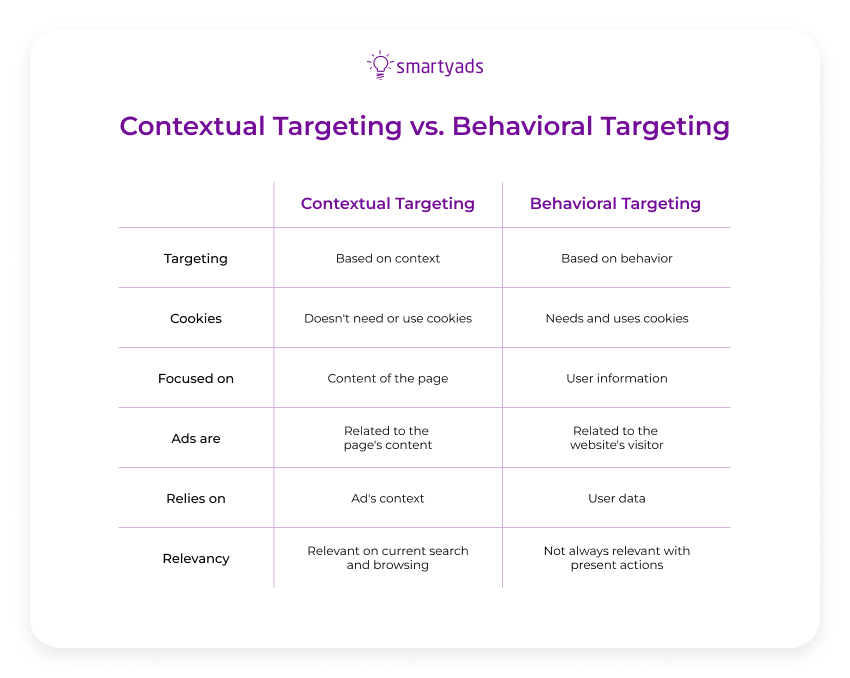Contextual targeting definition in the realm of digital contextual advertising is a strategy that revolves around presenting advertisements to users based on the context or content of the webpage they are actively browsing.
Contextual marketing differs from today's traditional approaches, which are built entirely around collecting user data. Instead, it prioritizes the relevance of ads in the surrounding content. Such advertising relies on engaging the user through content that they are interested in voluntarily rather than content that is randomly predicted by their behavior.

This method is employed with the goal of making ads more contextually relevant to users, thus increasing the likelihood of engagement with the target audience. It offers a nuanced and content-driven approach to advertising that resonates with the context of the page, potentially leading to more effective and engaging ad campaigns.
Why is contextual targeting important?
Contextual targeting plays a pivotal role in the realm of digital contextual advertising for several compelling reasons. Firstly, it bolsters the relevance of advertisements by ensuring they align with the content and context of the webpage where they appear.
The heightened relevance greatly boosts the chances of capturing users' attention and aligning with their individual interests.
Contextual targeting significantly enhances the overall user experience. By seamlessly integrating ads within the surrounding content, it cultivates a less intrusive and more harmonious browsing journey. Consequently, users are less inclined to perceive these contextual ads as disruptive, resulting in a more positive online experience.
What are the benefits of contextual targeting?
Contextual targeting in digital advertising has many undeniable advantages. First of all, it increases the relevance of ads by matching the content and context of the web pages being served.
User privacy
Contextual targeting emerges as a privacy-savvy alternative to intrusive tracking methods in an age dominated by data privacy concerns. It grants advertisers the ability to connect with their target audience while lessening their dependence on extensive user data, effectively tackling privacy apprehensions and potential regulatory challenges.
Personalized ad experience
Contextual targeting provides you with the authority of precise ad positioning within its surroundings. Advertisers have the autonomy to select the placement and adjacent content for their ads independently.
This empowers them to harmonize the brand message with the adjacent content, ensuring a competent delivery of the intended message to potential clients.
Also, contextual targeting reveals its versatility as a strategy applicable across various industries and niches. Promoting products, services, or content can be finely tailored to suit specific campaign objectives.
More affordable advertising method
Campaign performance is what makes contextual targeting truly attractive to advertisers. Synchronizing ads with relevant content often yields higher engagement and click-through rates (CTR). This inherently increases the effectiveness of ad campaigns and leads to a more favorable return on investment (ROI).
Contextual advertising arises as a cost-efficient strategy, combining precision and effectiveness. It enhances engagement and maximizes ad spend efficiency by delivering closely aligned ads with webpage content. Advertisers enjoy real-time optimization and scalability, customizing campaigns to their goals and budget. Operating on a pay-per-click model, this method assures cost control while attracting high-quality traffic.
Easier and more affordable to implement
Moreover, contextual targeting seamlessly adjusts to the dynamic Internet landscape. Advertisers can effortlessly tweak targeting criteria in response to current trends, breaking news, and emerging content, guaranteeing the relevance and timeliness of their campaigns.
Contextual targeting vs. behavioral targeting
In the field of contextual advertising, there are two main targeting methods: contextual and behavioral.
Contextual targeting primarily concerns webpage content. Advertisers employing this method aim to synchronize their ads with the context and subject matter of the hosting webpage. Emphasis is placed on relevance, ensuring the ads closely align with users' content-related interests and needs.
On the contrary, behavioral ad targeting relies on user data and their prior online engagements. It hinges on tracking user activities, including browsing history, search queries, and interactions with websites and applications. Behavioral targeting encompasses user profiling and segmentation, enabling advertisers to serve personalized ads based on a user's previous online behavior.
Sometimes context matters more than behavior
The core distinction between these two approaches lies in their dependence on user data. Behavioral targeting heavily relies on user data to forecast preferences and serve personalized ads. Conversely, contextual targeting minimizes the necessity for extensive user data by giving precedence to the immediate context of the user's content interaction.

Privacy considerations are a vital factor in this evaluation. Personalized behavioral targeting, reliant on user data, frequently encounters scrutiny and regulatory hurdles concerning data privacy and consent. In contrast, contextual targeting is seen as a privacy-conscious alternative, as it necessitates less intrusive tracking of individual user behavior.
Relevant ads without being creepy
Divergence in relevance and user experience is also evident between these two methods. Contextual targeting places prominence on delivering ads that seamlessly harmonize with the content, making them less obtrusive and more captivating for users. On the other hand, despite its personalization, behavioral targeting can sometimes raise concerns about privacy intrusion and the unsettling sensation of being tracked, especially with location targeting.
The choice between contextual and behavioral targeting often hinges on the objectives of a brand campaign. Contextual targeting, with its emphasis on content alignment, proves effective for brand awareness and campaigns targeting a broad audience. In contrast, behavioral advertising, characterized by precision and personalization, is often favored for campaigns targeting specific actions like conversions.
Both contextual and behavioral targeting have advantages, and the choice between them depends on factors such as campaign objectives, user privacy requirements, and desired level of personalization. In some cases, a hybrid strategy that combines elements of both targeting methods can yield the best results, ensuring relevance, user engagement, and privacy.
What is contextual traffic?
Contextual traffic refers to website visitors or users who arrive at a specific web page or online content based on their interests, search queries, or the context of the content they are currently engaging with. This type of traffic is driven by the relevance of the content to the user's preferences or needs.
Unlike other forms of traffic, such as direct or referral traffic, which may come from specific sources or links, contextual traffic relies on the alignment between the user's intent and the content they encounter.
For example, if a user searches for "best smartphones" on a search engine and clicks on a search result that leads to a tech review website discussing smartphone features and recommendations, that user is considered contextual traffic because their visit is driven by the relevance of the content to their initial search query.
Increased consumption of content
Contextual traffic is highly valuable for website owners and advertisers because it indicates that users are more likely to engage with the content or respond to ads that align with their current interests. It often leads to higher user engagement, longer time spent on the website, and increased chances of conversions, such as making a purchase or signing up for a newsletter.
To leverage contextual traffic effectively, website owners and advertisers can optimize their content and advertising strategies to align with specific keywords, topics, or user intent. This involves creating high-quality, relevant content and utilizing keyword targeting in advertising campaigns to attract users who are actively seeking information or products related to the content. Overall, contextual traffic plays a crucial role in driving user engagement and achieving online objectives.
Google AdSense and Contextual targeting
Google AdSense stands as a cornerstone of the digital advertising landscape, serving as a fundamental monetization tool for website owners and publishers. It presents a seamless avenue for content creators to accrue revenue by showcasing ads tailored to their web pages' context.
This contextual alignment is achieved through the advanced algorithms of Google Display Network, which meticulously assess target keywords, themes, and content subject matter to guarantee the utmost relevance and pertinence to users' current engagement.
This symbiotic relationship between content and advertising yields mutual benefits for publishers and advertisers. For publishers, it offers a user-friendly income-generation avenue that preserves the quality of the user experience. Website owners can enhance audience engagement and deliver valuable content by delivering pertinent ads. This, in turn, elevates the overall user experience and fosters visitor retention.
Cookie-less advertising
The advertising industry has long anticipated Google's move to disable third-party cookie support. Initially planned for 2020, this decision was delayed multiple times due to the pandemic and concerns from privacy advocates who feared Google would gain an unfair targeting advantage. Now, the gradual phase-out of third-party cookies has been officially confirmed and is set to commence in mid-2024. Contextual advertising is emerging as a crucial and privacy-compliant alternative in this evolving environment.
Contextual advertising operates by analyzing the content and context of a web page, ensuring that the ads displayed are directly more relevant ads to what users are currently engaged with. This approach respects user privacy and preferences and aligns with stringent privacy regulations, such as GDPR and CCPA.
One of the key advantages of contextual advertising is its ability to deliver contextually relevant ads, even in a cookie-less world. In fact, due to this, 42% of brands plan to increase their spending on contextual ads in 2023.
This user-centric approach enhances the overall online experience, as users are more likely to find these display-relevant ads valuable and engaging. As a result, contextual advertising often leads to better ad performance, with higher click-through rates and increased conversions.
Furthermore, contextual advertising is future-proof as it adapts to evolving privacy standards. In a landscape where privacy regulations continue to change, contextual advertising remains a reliable and effective method for reaching and engaging target audiences.
How to implement contextual targeting in my advertising campaigns
Implementing contextual targeting in your advertising endeavors is a multifaceted process that begins with choosing the right platform to launch a contextual advertising campaign. It can be difficult to get lost in the abundance of contextual advertising solutions because many platforms offer the various benefits we mentioned above.
It's up to you to decide which platform to use, but SmartyAds DSP, for example, has all the advantages you need for a competent and smooth-running contextual advertising campaign.
After choosing the right platform for advertising, establish your campaign goals and delineate your intended audience.
Next, delve into the intricacies of contextual relevance by identifying keywords and topics that seamlessly dovetail with your offerings. Keyword contextual targeting will serve as the lynchpin for aligning your advertisements with the appropriate content and context.
Your choice of an advertising platform plays a pivotal role in this context. Opt for a platform that mirrors your campaign's objectives and seamlessly integrates contextual targeting capabilities.
With the groundwork laid, craft contextual ad copy and creative that harmonize with the chosen keywords and topics. These elements should be tailored to seamlessly fit the content on the web pages where your contextual ads will appear.
Bidding strategies for contextual relevance will dictate your ad's prominence. They play a critical role in ensuring your advertisements resonate with the chosen context.
It's essential to wield ad placement exclusions judiciously. These exclusions prevent your contextual ads from appearing on web pages that aren't in sync with your brand or messaging.
To stay on course, closely monitor your campaign's performance, focusing on metrics such as click-through rates, conversion rates, and return on investment. Such data-driven insights will help you navigate the dynamic advertising landscape effectively.
Incorporate A/B testing to refine your ad copy, creative, and targeting parameters. This iterative process helps you identify the most potent variations that deliver optimal results.
Lastly, stay mindful of compliance with privacy regulations and adhere to the best practices that safeguard user data and privacy. This approach ensures that your contextual targeting practices remain ethically sound and effective in a world increasingly focused on data privacy.
Takeaways
Contextual marketing is a privacy-compliant alternative in a cookie-less advertising environment, prioritizing relevance and enhancing user engagement and ad performance. It respects user privacy and preferences by delivering ads based on the context of the content. This approach is adaptable to evolving privacy regulations while balancing ethical ad practices with effective audience engagement in a dynamic digital advertising landscape.
Start advertising with SmartyAds DSP now!
FAQ
Contextual targeting is an advertising strategy that delivers ads based on the context of web content. It matches ad content to the themes, keywords, and subject matter of the webpage, ensuring relevance for the audience. This approach respects user privacy, as it doesn't rely on individual user data but focuses on the content's context to enhance ad engagement.
Contextual targeting thrives in a cookie-less world because it doesn't rely on tracking user data. Instead, it focuses on the context of web content to serve relevant ads. This approach respects user privacy, aligns with stringent privacy regulations, and offers an effective alternative for advertisers to reach their target audience in a privacy-compliant manner.
Contextual targeting benefits businesses by ensuring their ads are displayed in contexts closely related to their products or services. This relevancy increases engagement, click-through rates, and conversion potential. It's a cost-effective method that respects user privacy and aligns with privacy regulations, making it an efficient and ethical choice for reaching target audiences.




